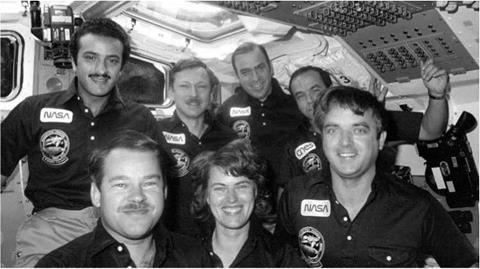STS 51-G
|
Int. Designation |
1985-048A |
|
Launched |
17 June 1985 |
|
Launch Site |
Pad 39A, Kennedy Space Center, Florida |
|
Landed |
24 June 1985 |
|
Landing Site |
Runway 23, Edwards Air Force Base, California |
|
Launch Vehicle |
OV-103 Discovery/ET-20/SRB BI-019/SSME #1 2109; |
|
#2 2018; #3 2012 |
|
|
Duration |
7 days 1 hr 38 min 52 sec |
|
Callsign |
Discovery |
|
Objective |
Satellite deployment mission |
Flight Crew
BRANDENSTEIN, Daniel Charles, 42, USN, commander, 2nd mission Previous mission: STS-8 (1983)
CREIGHTON, John Oliver, 42, USN, pilot
FABIAN, John McCreary, 43, USAF, mission specialist 1, 2nd mission Previous mission: STS-7 (1983)
NAGEL, Steven Ray, 38, USAF, mission specialist 2
LUCID, Shannon Wells, 42, civilian, mission specialist 3
BAUDRY, Patrick, 39, French Air Force, payload specialist 1
AL-SAUD, Prince Sultan Salman Abdul Aziz, 28, civilian, payload specialist 2
Flight Log
The smoothest Space Shuttle to date, STS 51-G, with the orbiter Discovery in tow, made a majestic, on-time lift-off at 07: 33 hrs local time from Pad 39A, carrying a cargo of three large communications satellites and a crew of seven which for the first time included passengers (or, more correctly, payload specialists) from two other countries, France (CNES) and Saudi Arabia. Three days later, the Mexican satellite, Morelos, Saudia Arabia’s Arabsat, and the USA’s Telstar were safely deployed en route to geostationary orbit, with the aid of PAM-D stages.
Another satellite payload, called SPARTAN 1, was deployed for an autonomous flight to conduct X-ray observations of the Milky Way, before it was retrieved by the RMS. 51-G also conducted the first manned Strategic Defense Initiative (SDI, or “Star Wars’’)-related tests, attempting, eventually successfully, to reflect a laser beam directed at the Shuttle from Hawaii back to Earth via a small mirror mounted on the orbiter’s mid-deck side hatch window. French crew member Baudry completed a programme of biomedical experiments similar to those flown by his colleague Jean – Loup Chretien aboard Salyut 7 the previous year. Baudry had been Chretien’s backup on that mission before completing an abbreviated Shuttle payload specialist
|
The multi-national STS 51-G crew. L to r: Al-Saud, Creighton, Nagel, Lucid, Fabian, Baudry and Brandenstein |
training programme in America. The experiments included studies in physiology, biology, materials processing, and astronomy. Al-Saud took photographs of his homeland, participated in several experiments (include assisting Baudry in his programme) and continued his religious commitments, fulfilling his Muslim customs as well as he could. He admitted that he could not totally “bend down” while floating, due to the tendency to cause space sickness; and facing Mecca created its own problems when he was orbiting Earth every 90 minutes.
Discovery came home to Edwards Air Force Base’s runway 23, making the shortest rollout so far, of 2,265 m (7,431 ft), only for its main landing gear to sink partially in the wet lake bed. It had to be rather ignominiously righted using a plank of wood. Flight time was T + 7 days 1 hour 38 minutes 52 seconds. Orbital inclination was 28.45° and maximum altitude was 334 km (208 miles).
Milestones
107th manned space flight
49th US manned space flight
18th Shuttle flight
5th flight of Discovery
1st flight by crew from three nations
1st flight by a Saudi Arabian
1st royalty in space (Al-Saud)
1st nation (France) to make space flights with both the USA and Russia











